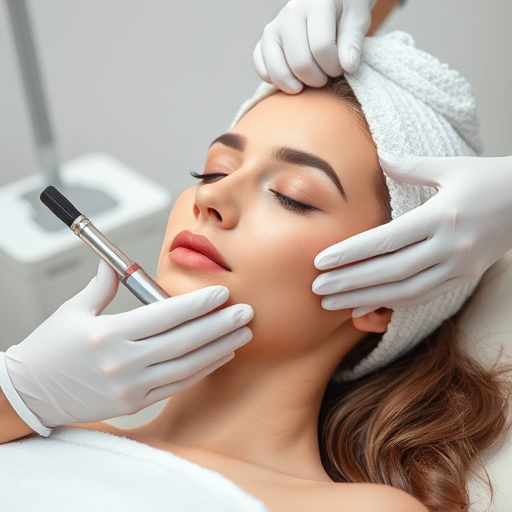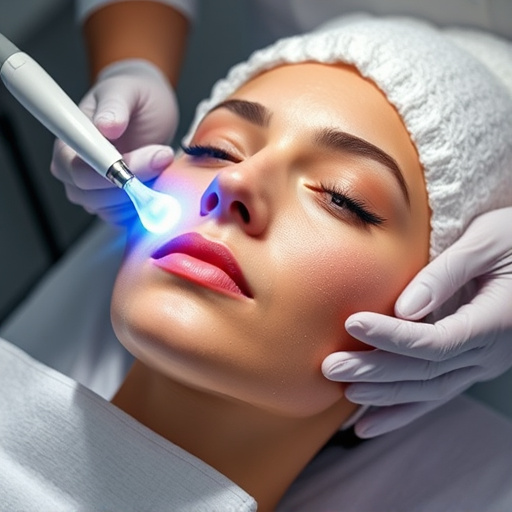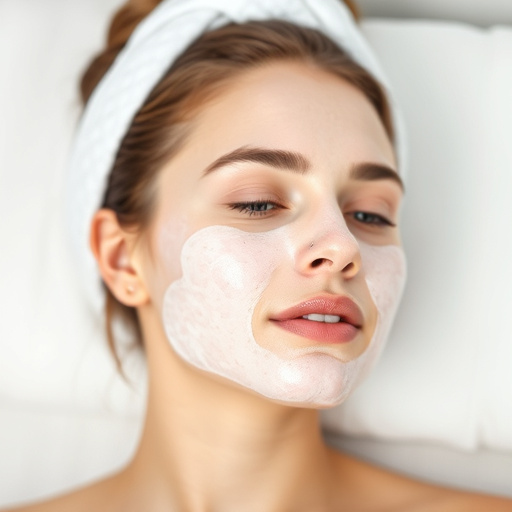Lactic acid peels are popular for smoothing fine lines, reducing age spots, and refining pores, but carry risks of mild irritation. Pre-peel preparation includes gentle cleansing and hydration, while post-care involves soothing products, daily sun protection (SPF 30+), and avoiding AHAs/BHAs for 24-48 hours to minimize adverse effects and promote optimal skin health.
Uncover the secrets to achieving flawless, smooth skin with lactic acid peels. This powerful ingredient offers a range of benefits, from exfoliation to collagen stimulation, but understanding its potential risks is crucial. Before you begin, learn how to prepare your skin for maximum results and minimal irritation. From choosing the right concentration to post-peel care, this guide will walk you through each step, ensuring a safe and effective lactic acid peel experience.
- Understanding Lactic Acid Peels: Benefits and Potential Risks
- Preparing Your Skin for the Peel: Essential Precautions
- Application and Post-Peel Care: Achieving Smooth Results Without Irritation
Understanding Lactic Acid Peels: Benefits and Potential Risks

Lactic acid peels are a popular skin treatment that involves applying a chemical solution of lactic acid to improve skin texture and appearance. This gentle yet effective exfoliant is known for its numerous benefits, including smoothing fine lines, reducing the appearance of age spots, and promoting healthier, brighter skin. It’s also an excellent choice for those seeking pore refinement, as it helps unclog pores and minimize their size, making it a favorite among dermatologists and medical spa services.
However, like any skincare procedure, there are potential risks associated with lactic acid peels. Some users may experience mild irritation, redness, or dryness, especially if their skin is sensitive. Over-application or using a higher concentration than recommended can lead to more severe reactions. It’s crucial to follow the instructions carefully and consult a dermatologist or licensed esthetician for guidance, particularly if you have specific skin concerns or conditions. Prioritizing skin health through proper use and expert advice ensures the best results while minimizing any adverse effects.
Preparing Your Skin for the Peel: Essential Precautions

Preparing your skin for a lactic acid peel is an essential step to ensure minimal irritation and optimal results. Before the treatment, it’s crucial to cleanse your skin gently and thoroughly, removing any makeup or sunscreen. A mild cleanser suitable for sensitive skin is ideal, as it won’t strip your skin of its natural oils. Additionally, hydration is key; start by using a hydrating serum or moisturizer to prepare your skin for the peel.
Lactic acid can be powerful, so it’s important to take precautions. Avoid exfoliating your skin for at least 24-48 hours before the peel to prevent excessive irritation. Sun exposure should also be minimized; always wear sunscreen during the day and steer clear of intense sunlight or UV beds for a week prior to the treatment. These simple measures will help ensure that your skin is in the best condition possible, enhancing the benefits of the lactic acid peel while keeping potential side effects to a minimum.
Application and Post-Peel Care: Achieving Smooth Results Without Irritation

After applying a lactic acid peel, it’s crucial to follow up with meticulous post-peel care for optimal results and to prevent any irritation. Start by gently cleansing your face with a mild, pH-balanced cleanser to remove any residual peel solution. Avoid using harsh scrubs or exfoliants as this can cause further stimulation of the skin. Next, apply a soothing moisturizer suitable for sensitive skin to hydrate and calm the treated area. This step is essential in maintaining the skin’s barrier function and reducing the risk of redness or itching.
Additionally, protect your skin from the sun by using a broad-spectrum sunscreen with at least SPF 30 during the day. Sun exposure can exacerbate sensitivity, especially after a chemical peel like lactic acid. Incorporate a physical sunscreen that contains zinc oxide or titanium dioxide for added safety. Lastly, be mindful of your skincare routine; steer clear of products containing strong alpha hydroxy acids (AHAs) or beta hydroxy acids (BHAs) for 24-48 hours post-peel to allow your skin to recover naturally and achieve a smoother, more even complexion without any adverse reactions.
Lactic acid peels offer a powerful way to exfoliate and rejuvenate skin, but achieving smooth results without irritation requires careful preparation and application. By understanding both the benefits and potential risks, taking necessary precautions, and following expert advice on post-peel care, you can safely incorporate lactic acid peels into your skincare routine, revealing smoother, brighter skin without discomfort.














